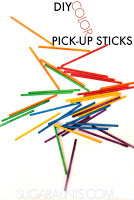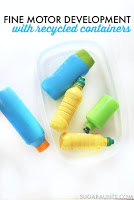There are many times throughout the day that hand separation in fine motor dexterity is used to stabilize and manipulate objects. But what do we mean by this phrase, “hand separation” and exactly What is Motoric Separation of the Two Sides of the Hand? We’ll get into that here, as well as cover specific separation of the sides of the hand to develop precision and refined fine motor skills.
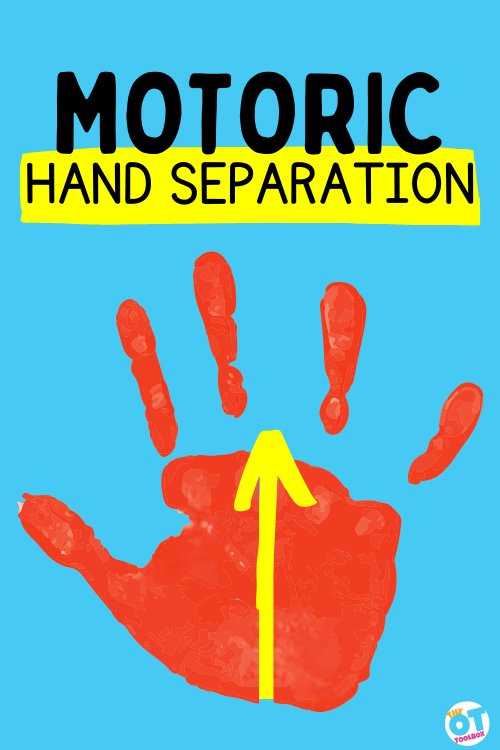
Motoric Hand Separation
Motoric hand separation is another term for separation of the two sides of the hand and is an important aspect of fine motor skills.
The term “motoric” refers to the motor actions, or the motor skills of the hand. This includes movements, grasp, precision of the fingers, intrinsic muscle strength needed to grasp and manipulate items.
When we refer to motor skills, we are talking about the physical movement of the hand to manipulate, grasp, and use objects by moving the hands.
Motoric skills requires coordination and refined motions of the muscles, joints, skin, and ligaments in the hand. Motoric use occurs in the fingers, palm, and wrist using the following joints:
- Wrist
- MCP joints
- PIP joints
- DIP joints
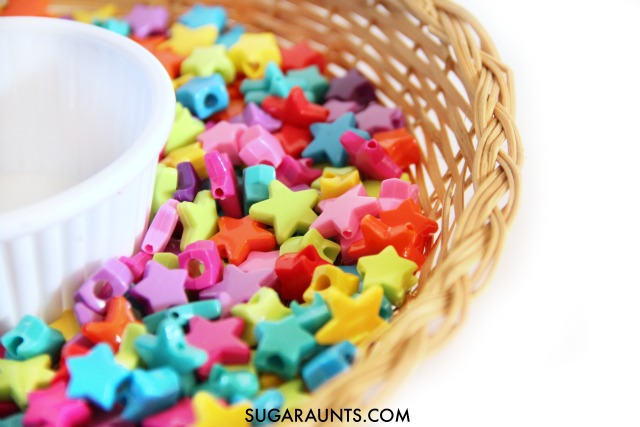
Definition of Hand Separation
Hand separation refers to the fine motor skill in which the two sides of the hand are separated into a “power side” and and “precision side”.
Refinement of fine motor skills like pencil grasp, manipulation of very small items, and managing zippers, shoe laces, and buttons with the precision half of the hand (the radial side) happens when the power half (the ulnar side) is stabilized.
You can imagine a line drawn from your wrist directly down the middle of your hand and between your ring finger and middle finger, separating the precision side of the hand (thumb, pointer finger, and middle finger) with the power side of your hand (pinkie finger and ring finger).
These two sides work together in skilled activities with precision and power grasp in functional activities. This motoric separation of the hands allows for in-hand manipulation skills.
You’ve seen hand separation day in and day out:
- A child is fumbling to manage the buttons on their sweater.
- A little one is zipping up their coat and they have the zipper and coat clenched between their pinkie fingers and thumbs.
- A Kindergarten student is learning to write letters on lines, but they’ve got the pencil in a clenched grasp, using their whole hand.
All of these examples indicate a fine motor need to work on motoric separation of the two sides of the hand.
The fingertips are used in so many small motor activities throughout the day, in functional tasks like self-care, dressing, eating, and everyday tasks. Part of these activities involves holding objects in the palm of the hand, manipulating the small objects, and using those materials in daily tasks. Most of this is done without even thinking about the process.
An alternative to a flexed position of the ring and pinkie fingers are when theses two digits are fully extended out and stretched out away from the hand (abducted). This positioning stabilizes the MCP arch and allows for control of the pointer and middle fingers.
Separation of the two sides of the hand allow for more precise use of the thumb.
Try this fun activity to work on separating the sides of the hand, using sponges you might have in your kitchen right now.
Full disclosure: This post contains affiliate links.
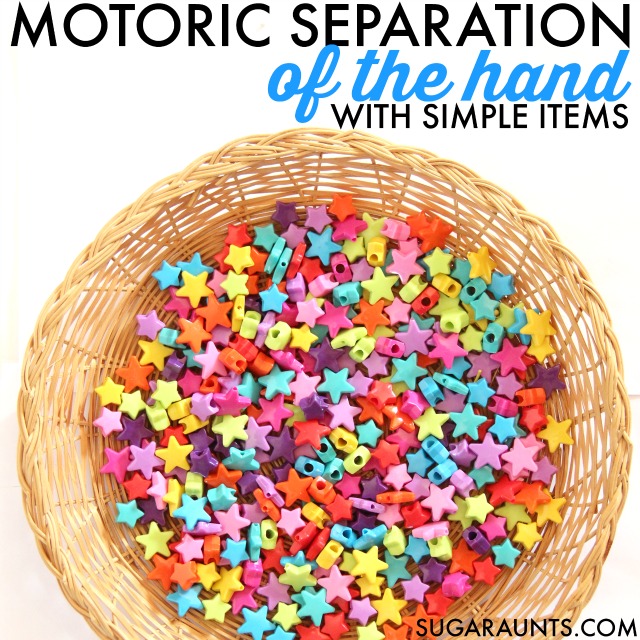
Assessing for Hand Separation in an OT Evaluation
As always, when completing an occupational therapy evaluation, the primary focus is on function, or the occupation that the individual needs to or wants to accomplish.
What is functionally happening? This is the main place to look when completing an OT eval.
When it comes to the fine motor aspect of functional performance, hand separation can impact precision, dexterity, refined motor skills, coordination. This can lead to safety issues in daily tasks. It can impact learning or performance of self-care. It can mean the individual can not accomplish a great number of functional tasks.
Hand separation is needed for dexterity. A functional fine motor grasp and manipulation of objects is more accurate when the ring and pinkie fingers are flexed (bent) into the palm.
Another intricate part of this fine motor puzzle is the stability offered through the upper body, including the core, shoulder girdle, elbow, and wrist. These areas can impact function, and as always, you should consider proximal stability before distal mobility.
Important things to consider in an occupational therapy evaluation include:
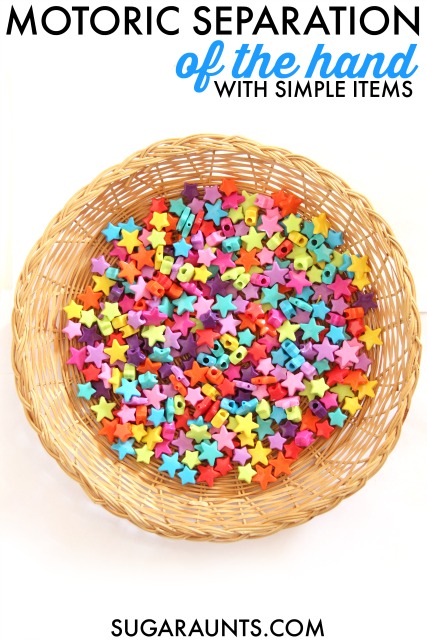
How does motoric separation of the hands develop?
Development of hand separation begins at a young age. We cover this progression in our resource on fine motor milestones.
Hand separation starts when a baby bears weight through their arm and ulnar side of the hand while carrying a toy in the radial side.
This simple activity developmentally lengthens the muscles of the ulnar side.
It’s through play that the separation of the hand develops. As toddlers become more refined at fine motor activities, they gain more dexterity in using just the precision side of the hand.
You’ll see this progression also with the development of pencil grasp.
Whole Hand Grasp- (Typically seen between 12 months-1.5 years) the child holds objects with their whole hand. It looks like they are holding a paint stirrer or potato masher.
Digital Pronate Grasp/ Pronated Wrist Grasp- (2-3 years) The child holds objects with a gross grasp and the wrist facing the ground, or in a pronated position.
Four Fingered Grasp- (3.5-4 years)- Items are held in the fingertips but using the thumb and all four fingers. There is not yet a clear separation of the sides of the hand.
Static Separation of the Sides of the Hand- (3.5-4 years)- The child will hold objects with the precision side of the hand, but there is not joint mobility in the precision side: The joints of the thumb, pointer finger, and middle finger do not move in isolation or as a group to manipulate objects. If there is mobility in the joints, it is crude with objects falling at times and manipulation skills needing more refinement. For example, a child at this age can place a coin into the slot of a vending machine, but they will drop the coin.
Dynamic separation of the Sides of the Hand- (4-6/7 years) With age, the child develops more refined motions in the precision side of the hand, and they are able to move the joints in isolation as they manipulate objects within the hand.
Lateral Separation of the Sides of the Hand- As the child gains more experience with precision skills, they are able to use more motor combinations in fine motor tasks. This looks like holding a key with the side of the pointer finger against the pad of the thumb as they insert a key into a door. Still more refined is holding a keychain of keys in the hand and moving the keys around to find the correct key and then position it between the thumb and lateral finger to unlock a door.
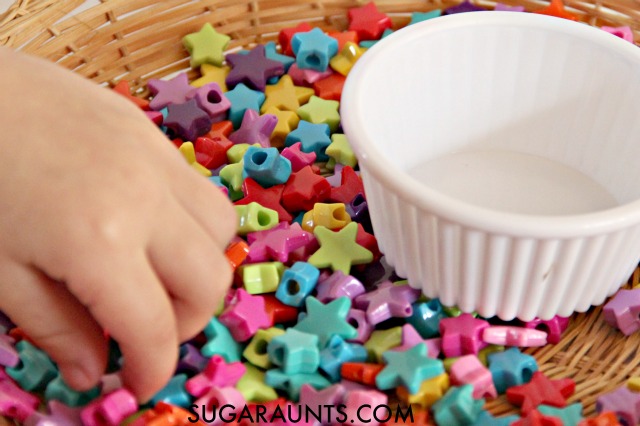
Activities to Improve Motoric Separation of the Two Sides of the Hand
- Flip coins
- Roll play dough into small balls
- Squeeze a spray bottle with the pointer and middle fingers
- Pick up small items and “squirrel them away” into the hands: mini marshmallows, cereal, small beads, coins, waterbeads. (affiliate links) (This is also called translation toward the palm.)
- Release the items (This is also called translation away from the palm.) Place coins into a piggy bank or beads into a cup.
- Hold a cotton ball in the palm with the ring and middle fingers while coloring, writing, or cutting with scissors.
Other activities to work on motoric separation of the hand include:
(Amazon affiliate links included below.)
- Tearing paper
- Crumbling paper
- Playing with a Light Bright toy
- Using tweezers to pick up and move small objects like mini erasers
- Using pegs or beads and play dough like in this thumb wrap grasp activity
- Precision grasp activities
- Pincer grasp activities
- Use the hands to pick up and manipulate small objects
- Use food coloring bottles to squeeze water or food coloring onto paper in cooking or painting activities
- Homemade Pencil Grip
- DIY Pick-Up Sticks for finger isolation and precision skills
- Gross Grasp with Recycled Containers for building hand strength
- Finger Isolation Fingerprint Activities
- Use tweezers to squeeze objects and pick them up or place them in sorting activities (use materials like craft pom poms, cotton balls, beads, etc.)
- Play with these craft stick tweezers
- Manipulate paper clips or play paper clip games
- Use tongs to pick up objects
- Stack mini erasers
- Play with clay
- Use these clay strengthening activities
- Poke toothpicks into clay or play dough
- Sort beans into cups according to color
- Cut straws into pieces and thread them onto string or toothpicks
- Play the game Hi Ho Cherry-O
- Building puzzles
- Playing with stickers
- These upper extremity strength activities for toddlers
- Press push pins into a bulletin board or use poke art pages like the ones in our Fine Motor Kits
- Press push pins into a plastic lid
- Play with pegboard activities
- Cut a slit in the lid of a yogurt container and press coins into the slit
- Use the fingertips to put on lotion or cream onto the fingers of the other hand
- Tear paper into pieces
- Build with LEGOs
- Squirt water guns at a target
- Draw in sand using the pointer finger
- Play with silly putty
- Shoot marbles
- Clip paperclips onto the edge of index cards
- Stretch rubber bands over the neck of the bottle using a recycled water bottle
- Play in a rice sensory bin using the pointer finger to draw. (a great writing tray activity)
One way to develop hand strength and the refined motor skills needed for motoric separation of the sides of the hand is this beads sorting activity.
You’ll need just a couple of materials to set up this fine motor therapy exercise:
- Beads
- Two bowls or containers
This is one of the most simple therapy exercises and it has a powerful impact on developing motoric separation of the sides of the hand.
- To set up this therapy exercise, place all of the beads into one of the containers. We used star beads but any beads or small items can work for this activity. You can find the star beads here. (affiliate link)
- Next, I placed the beads into a shallow basket and asked my kids to grab only one color that they liked best.
- They then tried to hold as many of that one color in their hand while picking up more beads.
- When they couldn’t possibly hold anymore beads in their cute little hands, I showed them how to drop them into a small cup one at a time, while counting how many beads they had.
This type of activity is a version of in-hand manipulation called translation.

Working on fine motor skills, visual perception, visual motor skills, sensory tolerance, handwriting, or scissor skills? Our Fine Motor Kits cover all of these areas and more.
Check out the seasonal Fine Motor Kits that kids love:






Or, grab one of our themed Fine Motor Kits to target skills with fun themes:
- Frogs Fine Motor Kit
- Unicorns Fine Motor Kit
- Vehicles Fine Motor Kit
- Apple Fine Motor Kit
- Back to School Kit
- Sports Fine Motor Kit
- Outer Space Fine Motor Kit
- Fairytale Fine Motor Kit
- Plus more in our shop!
Want access to all of these kits…and more being added each month? Join The OT Toolbox Member’s Club!

Colleen Beck, OTR/L has been an occupational therapist since 2000, working in school-based, hand therapy, outpatient peds, EI, and SNF. Colleen created The OT Toolbox to inspire therapists, teachers, and parents with easy and fun tools to help children thrive. Read her story about going from an OT making $3/hour (after paying for kids’ childcare) to a full-time OT resource creator for millions of readers. Want to collaborate? Send an email to contact@theottoolbox.com.



